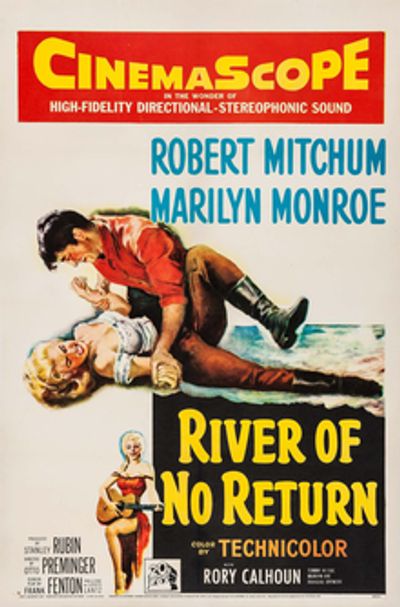
Where Was River of No Return Filmed? Exploring Banff National Park & Iconic Locations
1954
 City Locations
City Locations
Alberta (Canada), Los Angeles (USA)
 Location Types
Location Types
Film Studio, Riverside, Unique, Unusual
 Location Styles
Location Styles
Dated, Retro, Neglected, Sail
About River of No Return
River of No Return is a timeless Western masterpiece set in the Northwestern United States in 1875. The captivating narrative follows the journey of Matt Calder, a resilient widower portrayed by the legendary Robert Mitchum, who embarks on a fresh chapter of his life after his release from prison. Matt's path is intertwined with a series of formidable challenges that put his resilience and character to the ultimate test. The story takes an unexpected twist when Matt's young son, Mark, and a spirited saloon singer named Kay (portrayed by Marilyn Monroe) join him on a journey along the treacherous Salmon River. Together, they embark on a perilous adventure after their rifle and horse are stolen by Harry Weston, a deceitful gambler. Amidst the unforgiving wilderness, they must navigate the challenges of nature, confront hostile Native Americans, and battle their demons. The characters find themselves entangled in a web of danger, love, and redemption throughout their journey. As they fight for survival, they must confront their past and make difficult choices to secure their future. River of No Return explores themes of family, honor, and the pursuit of freedom in a rugged and unforgiving frontier.
River of No Return Locations
River of No Return, the iconic 1954 Western film, utilized various stunning locations for its production. While the movie is set in the Northwestern United States, most scenes were shot in Alberta, Canada. Filming occurred in notable regions such as Banff National Park, Jasper National Park, and the Salmon and Bow Rivers. These locations provided a breathtaking backdrop of rugged wilderness, majestic mountains, and pristine rivers. The picturesque landscapes anchor to landmarks like Banff Springs and Lake Louise, adding to the film's visual allure. Exploring these filming locations would undoubtedly be worthwhile for both fans of the movie and nature enthusiasts alike, offering an opportunity to immerse oneself in the same stunning surroundings that graced the screen in River of No Return.
Fun Fact
Did you know? River of No Return marked Marilyn Monroe and Robert Mitchum's first-ever collaboration. Their incredible on-screen chemistry and captivating performances contributed to the film's lasting legacy, solidifying it as an iconic milestone in their illustrious careers.
Kay falls into the river scene in River of No Return
Banff National Park, Improvement District No. 9, AB, Canada
Kay (Marilyn Monroe) falls during a rafting trip on the treacherous river. Matt Calder (Robert Mitchum) and his son Mark (Tommy Rettig) are forced to take Kay on a raft after losing their rifle and horse. As they navigate the rapids of the River of No Return, Kay falls into the water, creating a tense moment for the characters. Banff National Park, located in Alberta, Canada, is a breathtaking destination known for its stunning landscapes and outdoor adventures. Established in 1885, it is Canada's first national park and covers a vast area of 6,641 square kilometers. With its majestic Rocky Mountain peaks, turquoise glacial lakes, and diverse wildlife, Banff offers a picture-perfect mountain experience. Visitors can indulge in hiking, wildlife spotting, skiing, and exploring the iconic Icefields Parkway. It's a must-visit destination for nature enthusiasts and outdoor lovers. Banff National Park in Alberta, Canada, is easily accessible by car, bus, or shuttle services. Located west of Calgary, it is a straightforward drive via the Trans-Canada Highway. Bus options from Improvement District No. 9 and shuttle services from Calgary International Airport are also available for convenient transportation.
Filming Locations Scout
Matt and Kay arguing scene in River of No Return
Salmon River, Idaho, USA
As the farm comes under attack from hostile Native Americans, the three individuals find themselves compelled to flee down the river on Harry's (Rory Calhoun) raft. After a long and eventful day, they establish a campsite by the river. Amid this calm, Matt (Robert Mitchum) and Kay (Marilyn Monroe) discuss the decision to pursue Harry. Expressing his concerns, Matt questions why Kay would opt to marry someone who placed a child in danger. In response, Kay reminds him that, unlike Matt, Harry has never taken another person's life. The Salmon River, famously known as "The River of No Return," flows gracefully through the picturesque landscapes of Idaho, USA. It is the longest undammed and free-flowing river within a single state across the lower 48 states. As it carves its way through the untouched wilderness of the Frank Church River of No Return Wilderness, the Salmon River presents awe-inspiring vistas and exhilarating opportunities for whitewater rafting. To reach the Salmon River, visitors can fly into Boise, Idaho, or Missoula, Montana, and then drive or charter a flight from either airport to Salmon. If you prefer driving, you can reach Salmon by road. The exact route will depend on your starting location, but Salmon is accessible by car.
Explore Video Shoot Locations
Conclusion
The filming locations for River of No Return epitomize the diverse beauty and cinematic allure of Alberta, Canada, and Los Angeles, USA. Alberta's rugged landscapes provided the untamed wilderness setting that breathed life into the film's wilderness scenes. The meandering Bow River and the picturesque Kootenay Plains served as captivating backdrops, offering a visceral connection to nature. With its versatile urban canvas, Los Angeles complemented the film's narrative with its dynamic cityscapes and diverse neighborhoods. Iconic locations like Griffith Park, its sprawling vistas, and the LA River lent authenticity to crucial scenes. The synergy between these contrasting yet complementary filming locales enriched the visual storytelling of River of No Return and underscored the thematic depth of the narrative. Alberta's untamed beauty and Los Angeles' urban diversity converged to create a cinematic experience that resonated deeply with the essence of the story – an exploration of nature, survival, and the human spirit against contrasting backdrops.